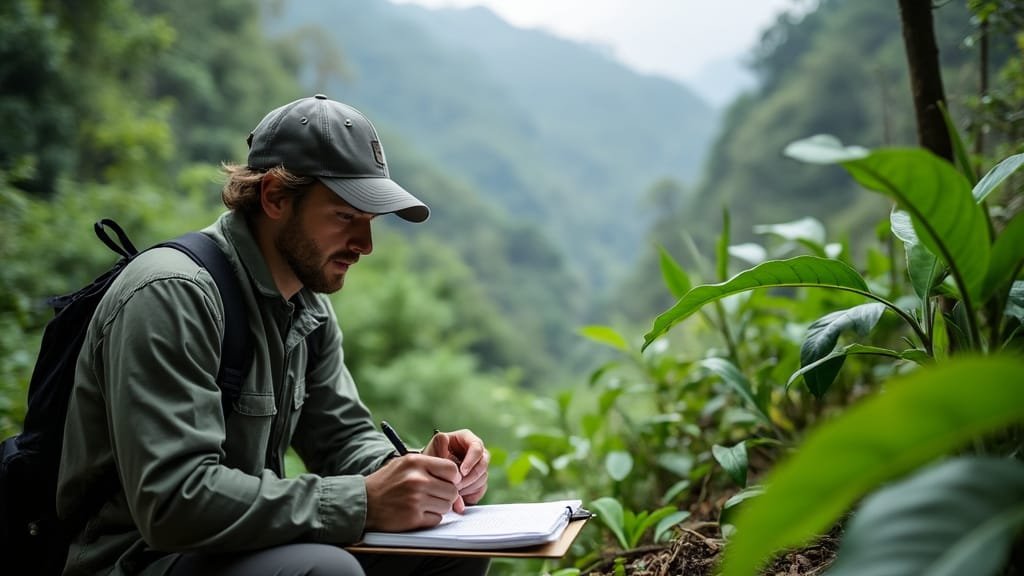Introduction
The latest conservation studies on red pandas focus on critical areas like population tracking, habitat restoration, genetic diversity, and community involvement. With red pandas facing threats from habitat loss, climate change, and poaching, researchers are employing advanced technologies and collaborative efforts to understand and protect these endangered animals
This article explores ongoing research that aims to preserve red panda habitats, improve their genetic health, and engage local communities in conservation, offering hope for the species’ survival in the Himalayan forests
Population Tracking and Monitoring Efforts
Tracking and monitoring wild red panda populations are crucial for conservation, as they provide data on population size, movement patterns, and habitat use. Current studies employ technologies like GPS tracking and camera traps, helping researchers gather real-time data on red panda behavior and territory
These monitoring techniques offer valuable insights into the daily lives of red pandas, allowing conservationists to develop effective strategies for habitat protection and species recovery
GPS and Radio Tracking of Red Pandas
One of the primary methods used in red panda research is GPS and radio tracking, which involves fitting red pandas with collars that transmit location data
This technology allows researchers to monitor individual animals across their territory, tracking their movements, home range size, and habitat preferences
These studies, as noted by Thapa and Sherpa (2022), provide data on how red pandas navigate their forested environment, identify safe areas for resting and foraging, and avoid potential threats
GPS tracking data also reveal patterns in red panda movement, allowing researchers to identify critical corridors that connect fragmented forest areas. This information is valuable for implementing habitat conservation measures, as it highlights the specific areas that require protection to support red panda populations effectively
Camera Traps and Behavioral Observations
Camera traps are another essential tool for monitoring red pandas in their natural habitat. Strategically placed in known red panda habitats, these cameras capture images and videos of red pandas as they go about their daily activities
Camera trap footage offers insights into red panda behavior, social interactions, and activity patterns, providing a glimpse into their mostly solitary lives. The photos and videos also allow scientists to identify individual red pandas based on unique markings and behaviors
Behavioral data collected from camera traps help researchers understand factors such as seasonal activity changes, preferred food sources, and reproductive behaviors
This non-intrusive tracking method offers a detailed view of red panda behavior without disturbing their natural routines, making it a vital tool in red panda conservation research
Challenges in Field Tracking and Data Collection
Despite the benefits of tracking technologies, field research on red pandas poses certain challenges. Due to their elusive nature and preference for dense bamboo forests, red pandas can be difficult to locate and observe in the wild
The high-altitude environments where red pandas live can also be challenging for researchers, with difficult terrain, limited accessibility, and unpredictable weather conditions affecting fieldwork
Another challenge is battery life in tracking devices, as well as the risk of collars falling off or malfunctioning. These obstacles require continuous innovation in tracking technology and additional resources to support extended field research
Despite these difficulties, advances in GPS and camera technology continue to improve red panda research, making it easier for conservationists to monitor and protect wild populations
Habitat Restoration and Climate Impact Studies
Red panda conservation efforts are closely linked to habitat preservation, as the loss of forested areas directly threatens their survival. Recent studies focus on reforestation, bamboo growth projects, and the effects of climate change on red panda habitats
By restoring forest areas and examining environmental shifts, conservationists aim to ensure a stable habitat for red pandas that can support healthy populations over the long term
Reforestation and Bamboo Growth Projects
One key area of habitat restoration involves reforestation projects that prioritize bamboo growth, which is essential for red pandas’ diet
Bamboo replanting and forest connectivity efforts are underway in regions where deforestation has fragmented red panda habitats, reducing their available food sources. By planting bamboo and other native trees, researchers hope to restore degraded lands and increase food security for red pandas
In addition to reforestation, these projects also establish corridors that connect isolated habitats, which is critical for allowing red pandas to move between forested areas safely
According to Yu and Li (2019), such habitat corridors are essential for maintaining genetic diversity and reducing the risks associated with inbreeding. These efforts not only support red pandas but also enhance biodiversity across forest ecosystems, benefitting other wildlife species
Assessing Climate Change Effects on Habitat
Climate change poses a significant threat to red panda habitats by altering temperature and precipitation patterns in the Himalayan region. As temperatures rise, suitable habitat areas for red pandas may shift to higher altitudes, forcing the animals into increasingly limited and competitive environments
Researchers like Kumar and Wangmo (2021) are studying how these climate changes impact bamboo growth and forest composition, both of which are critical for red panda survival
These climate impact studies involve tracking temperature fluctuations, analyzing changes in vegetation, and modeling future habitat suitability under different climate scenarios
This research enables conservationists to identify at-risk areas and prioritize them for restoration, helping to protect red panda habitats from the most severe impacts of climate change
Forest Fragmentation and Connectivity Solutions
Forest fragmentation is a major challenge for red panda conservation, as it isolates populations and limits access to essential resources. To counteract this, researchers are implementing connectivity solutions that bridge fragmented habitats
These solutions include constructing “green corridors” that provide safe passageways for red pandas to move between forest patches and access new areas for foraging and breeding
Fragmentation studies are critical for developing strategies to reduce human encroachment, as well. Conservationists are working with local communities to implement sustainable land-use practices that minimize habitat disruption, ensuring that forest areas remain interconnected and accessible to red pandas
This research is key to maintaining red panda populations in the face of expanding human activity and habitat loss
Genetic Diversity and Health Assessments
Conservation efforts increasingly focus on the genetic health and diversity of red panda populations to prevent inbreeding and strengthen their resilience to environmental challenges
Genetic studies provide valuable insights into population health, helping conservationists identify vulnerabilities and develop strategies to maintain genetic diversity. These assessments support the long-term survival of red pandas by promoting a robust and adaptable population
Genetic Studies for Population Health
Genetic studies are essential for understanding the genetic makeup of red panda populations and identifying any signs of genetic bottlenecks or inbreeding. By analyzing DNA from both captive and wild red pandas, researchers can determine genetic diversity levels and detect potential health risks associated with low diversity
Studies by Chen and Wei (2023) indicate that isolated red panda populations show reduced genetic variability, which may impact their ability to adapt to environmental changes
These genetic assessments guide breeding programs in zoos and conservation centers by prioritizing individuals with distinct genetic profiles for reproduction
By doing so, scientists can reduce the risk of inbreeding and help maintain a healthy gene pool, which is essential for the long-term survival of red pandas in the wild and in captivity
Inbreeding and Genetic Diversity Concerns
One of the primary genetic concerns in red panda conservation is inbreeding, which can lead to health issues, reduced fertility, and increased vulnerability to disease
Isolated red panda populations are particularly at risk of inbreeding due to habitat fragmentation, which limits their ability to interact and mate with genetically diverse individuals. Inbreeding reduces genetic diversity, weakening the population’s overall resilience to threats such as climate change, habitat loss, and disease outbreaks
To combat inbreeding, conservationists track the genetic lineage of red pandas in captivity and implement genetic monitoring in wild populations
This information helps establish breeding pairs that enhance genetic diversity, ensuring that future generations have a better chance of adapting to environmental changes
Improving Red Panda Health through Genetics
Beyond understanding population genetics, conservationists also use genetic information to assess individual health and monitor the prevalence of hereditary conditions
Genetic testing can identify potential carriers of genetic diseases, allowing researchers to make informed breeding decisions that reduce the likelihood of passing on harmful traits. This approach improves the health and longevity of red panda populations, both in captivity and in the wild
Furthermore, genetic studies help scientists understand red pandas’ adaptive traits, such as their digestive adaptations for bamboo consumption and their physical resilience to high-altitude environments. By identifying these traits, researchers can gain insight into the red panda’s evolutionary history and develop targeted conservation practices that support their survival
This research underscores the role of genetic diversity as a foundation for building a resilient red panda population capable of withstanding future environmental pressures
Community-Based Conservation Initiatives
Community involvement is a crucial aspect of red panda conservation, particularly in regions where red pandas’ habitats overlap with human settlements
Conservation programs that engage local communities through education, anti-poaching efforts, and sustainable tourism offer dual benefits: they protect red pandas while also supporting local livelihoods
By collaborating with local people, researchers and conservationists create programs that promote environmental stewardship and foster a sense of shared responsibility for red panda conservation
Local Education and Awareness Programs
Education programs are designed to inform local communities about the ecological importance of red pandas and the threats they face, including habitat loss and poaching
These programs, often run in partnership with schools, community centers, and conservation organizations, aim to build awareness from a young age. Activities may include workshops, storytelling sessions, and field trips that allow community members to observe red pandas in protected habitats
Research by Rai and Tiwari (2020) indicates that when communities understand the ecological role of red pandas, they are more likely to support conservation measures
By fostering a deeper understanding of red pandas and their habitat, education programs help reduce habitat destruction and encourage sustainable practices that benefit both wildlife and the local population
Anti-Poaching Efforts and Community Patrols
Anti-poaching initiatives are essential to protecting red pandas, as poaching poses a serious threat to their survival. Community-based patrols are an effective way to deter illegal hunting, involving local residents in regular forest monitoring to detect and prevent poaching activities
These patrols not only protect red pandas but also promote a sense of ownership and pride within the community, strengthening local commitment to wildlife protection
Many conservation organizations provide training and resources to help local patrols effectively monitor red panda habitats. These efforts are often coupled with incentives, such as eco-friendly livelihood programs, that offer economic alternatives to poaching
By involving communities directly in anti-poaching activities, conservationists establish a cooperative approach that reduces the risk of red panda poaching
Sustainable Tourism and Conservation Funding
Sustainable tourism has become an important component of red panda conservation, providing an economic incentive for communities to protect these animals and their habitats
In areas where red panda sightings attract tourists, local businesses and guides benefit from increased revenue, creating a positive economic cycle that supports conservation. Conservation groups and local governments often collaborate to establish guidelines for sustainable tourism, ensuring that red panda habitats are respected and protected
Funds generated from sustainable tourism initiatives are frequently reinvested in conservation programs, supporting activities such as habitat restoration, educational outreach, and anti-poaching efforts
By linking tourism with red panda conservation, these programs create a mutually beneficial model that fosters environmental stewardship and provides economic opportunities for communities
Conclusion
Recent conservation studies on red pandas highlight a multifaceted approach to safeguarding this endangered species. By employing advanced tracking techniques, researchers are able to monitor red panda populations and gain insights into their behavior and habitat use
Meanwhile, habitat restoration projects and climate impact studies address the environmental challenges red pandas face, working to preserve and expand the forested areas critical for their survival. Genetic research adds another layer of protection, helping maintain genetic diversity and address health risks, which are crucial for the long-term resilience of red panda populations
Community-based initiatives play a pivotal role in conservation success by engaging local residents through education, anti-poaching efforts, and sustainable tourism
These programs create partnerships between conservationists and communities, fostering a shared commitment to protecting red pandas and their habitats
As research and conservation practices continue to evolve, the collaborative efforts of scientists, local communities, and conservation organizations offer hope for the future of red pandas in the wild, ensuring that these unique animals can thrive in their natural environment for generations to come





